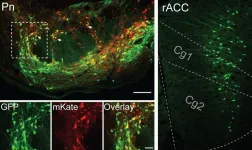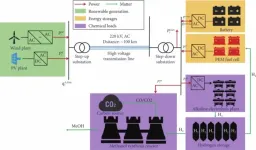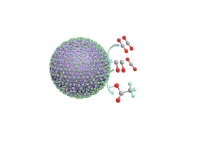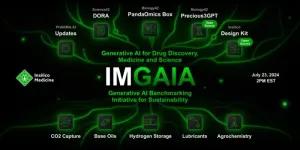(Press-News.org) CHAPEL HILL, NC – The placebo effect is very real. This we’ve known for decades, as seen in real-life observations and the best double-blinded randomized clinical trials researchers have devised for many diseases and conditions, especially pain. And yet, how and why the placebo effect occurs has remained a mystery. Now, neuroscientists have discovered a key piece of the placebo effect puzzle.
Publishing in Nature, researchers at the University of North Carolina School of Medicine– with colleagues from Stanford, the Howard Hughes Medical Institute, and the Allen Institute for Brain Science – discovered a pain control pathway that links the cingulate cortex in the front of the brain, through the pons region of the brainstem, to cerebellum in the back of the brain.
The researchers, led by Greg Scherrer, PharmD, PhD, associate professor in the UNC Department of Cell Biology and Physiology, the UNC Neuroscience Center, and the UNC Department of Pharmacology, then showed that certain neurons and synapses along this pathway are highly activated when mice expect pain relief and experience pain relief, even when there is no medication involved.
“That neurons in our cerebral cortex communicate with the pons and cerebellum to adjust pain thresholds based on our expectations is both completely unexpected, given our previous understanding of the pain circuitry, and incredibly exciting,” said Scherrer. “Our results do open the possibility of activating this pathway through other therapeutic means, such as drugs or neurostimulation methods to treat pain.”
Scherrer and colleagues said research provides a new framework for investigating the brain pathways underlying other mind-body interactions and placebo effects beyond the ones involved in pain.
The Placebo Paradox
It is the human experience, in the face of pain, to want to feel better. As a result – and in conjunction with millennia of evolution – our brains can search for ways to help us feel better. It releases chemicals, which can be measured. Positive thinking and even prayer have been shown to benefit some patients. And the placebo effect – feeling better even though there was no “real” treatment – has been documented as a very real phenomenon for decades.
In clinical research, the placebo effect is often seen in what we call the “sham” treatment group. That is, individuals in this group receive a fake pill or intervention that is supposed to be inert; no one in the control group is supposed to see a benefit. Except that the brain is so powerful and individuals so desire to feel better that some experience a marked improvement in their symptoms. Some placebo effects are so strong that individuals are convinced they received a real treatment meant to help them.
In fact, it’s thought that some individuals in the “actual” treatment group also derive benefit from the placebo effect. This is one of the reasons why clinical research of therapeutics is so difficult and demands as many volunteers as possible so scientists can parse the treatment benefit from the sham. One way to help scientists do this is to first understand what precisely is happening in the brain of someone experiencing the placebo effect.
Enter the Scherrer lab
The authors of the Nature paper knew that the scientific community’s understanding of the biological underpinnings of pain relief through placebo analgesia – when the positive expectation of pain relief is sufficient for patients to feel better – came from human brain imaging studies, which showed activity in certain brain regions. Those imaging studies did not have enough precision to show what was actually happening in those brain regions. So Scherrer’s team designed a set of meticulous, complementary, and time-consuming experiments to learn in more detail, with single nerve cell precision, what was happening in those regions.
First, the researchers created an assay that generates in mice the expectation of pain relief and then very real placebo effect of pain relief. Then the researchers used a series of experimental methods to study the intricacies of the anterior cingulate cortex (ACC), which had been previously associated with the pain placebo effect. While mice were experiencing the effect, the scientists used genetic tagging of neurons in the ACC, imaging of calcium in neurons of freely behaving mice, single-cell RNA sequencing techniques, electrophysiological recordings, and optogenetics – the use of light and fluorescent-tagged genes to manipulate cells.
These experiments helped them see and study the intricate neurobiology of the placebo effect down to the brain circuits, neurons, and synapses throughout the brain.
The scientists found that when mice expected pain relief, the rostral anterior cingulate cortex neurons projected their signals to the pontine nucleus, which had no previously established function in pain or pain relief. And they found that expectation of pain relief boosted signals along this pathway.
“There is an extraordinary abundance of opioid receptors here, supporting a role in pain modulation,” Scherrer said. “When we inhibited activity in this pathway, we realized we were disrupting placebo analgesia and decreasing pain thresholds. And then, in the absence of placebo conditioning, when we activated this pathway, we caused pain relief.
Lastly, the scientists found that Purkinje cells – a distinct class of large branch-like cells of the cerebellum – showed activity patterns similar to those of the ACC neurons during pain relief expectation. Scherrer and first author Chong Chen, MD, PhD, a postdoctoral research associate in the Scherrer lab, said that this is cellular-level evidence for the cerebellum’s role in cognitive pain modulation.
“We all know we need better ways to treat chronic pain, particularly treatments without harmful side effects and addictive properties,” Scherrer said. “We think our findings open the door to targeting this novel neural pain pathway to treat people in a different but potentially more effective way.”
This project was supported by the National Institutes of Health grants R01NS106301 and R01DA05483, the New York Stem Cell Foundation, the Stanford School of Medicine Dean’s Fellowship, seed funds from Biogen, the Stanford Mind, Brain, Computation and Technology Program, and the Vannevar Bush Faculty Fellowship
Other authors of this paper at the time of this research are Jesse Niehaus, Karen Huang, Alexander Barnette, Adrien Tassou, Kimberly Ritola, and Adam Hantman at the UNC School of Medicine; Fatih Dinc, and Mark Schnitzer at Stanford/Howard Hughes Medical Institute; Andrew Shuster at Harvard; Lihua Wang and Andrew Lemire of the Howard Hughes Medical Institute Janelia Research Campus: Vilas Menon at Columbia; and Hongkui Zeng at the Allen Institute for Brain Science.
END
Neuroscientists discover brain circuitry of placebo effect for pain relief
UNC School of Medicine research reveals a pain control pathway from the cortex to cerebellum crucial for placebo analgesia – when the expectation of pain relief leads to pain alleviation without a therapeutic intervention, such as with a drug
2024-07-24
ELSE PRESS RELEASES FROM THIS DATE:
'Gene misbehavior' widespread in healthy people
2024-07-24
Scientists have uncovered that ‘gene misbehaviour’ – where genes are active when they were expected to be switched off – is a surprisingly common phenomenon in the healthy human population.
The team also identify several mechanisms behind these gene activity errors. This may help inform precision medicine approaches and enable the development of targeted therapies to correct expression.
Researchers from the Wellcome Sanger Institute, the University of Cambridge and AstraZeneca studied the activity of inactive genes in a large, healthy population for the first time. While rare at the individual gene level, they revealed misexpression ...
Arc Institute welcomes first Scientific Advisory Board members; appoints two new members to Board of Directors
2024-07-24
Today, Arc Institute, the scientific research organization pioneering new models for scientific discovery and translation, is announcing the creation of its Scientific Advisory Board and its first two Scientific Advisors, as well as the appointment of two new members to the Arc Board of Directors.
New Scientific Advisory Board
Dr. Carolyn Bertozzi, Ph.D., and Dr. Aviv Regev, Ph.D., join as the first two members of Arc’s Scientific Advisory Board and will provide strategic guidance, share their ...
NCCN Oncology Research Program celebrates 25 years of advancing cancer science
2024-07-24
PLYMOUTH MEETING, PA [July 24, 2024] — The National Comprehensive Cancer Network® (NCCN®)—an alliance of leading cancer centers—commemorates the 25th anniversary of the NCCN Oncology Research Program (ORP). The NCCN ORP is dedicated to seeking innovative, effective, and equitable cancer care through oversight and funding for cancer research and quality improvement projects. Over the past quarter-century, the NCCN ORP has managed a diverse portfolio of more than 180 research studies and quality improvement projects to improve quality and outcomes for people with cancer. The NCCN ORP has also provided project oversight to 75 NCCN Foundation® Young Investigator Award ...
From grey to green: unveiling the future of renewable e-methanol for cleaner shipping fuels
2024-07-24
Methanol is a crucial chemical feedstock and a potential green fuel, particularly for the shipping industry. Currently, its production predominantly relies on fossil feedstocks, leading to high greenhouse gas emissions. With the global push towards decarbonization, there is an urgent need to explore cleaner alternatives like renewable e-methanol. Based on these challenges, there is a need for in-depth research to develop sustainable methanol production methods.
A team of researchers from Tsinghua ...
A brittle interface with low modulus to improve the mechanical properties of multiphase ceramics: A unique design approach?
2024-07-24
Barium strontium aluminum silicate (BaxSr1−xAl2Si2O8, BSAS) ceramics possess both phase stability and resistance to water vapor corrosion, making them ideal materials for radome technology and electronic packaging. To address the low tolerance of BSAS ceramics to damage and defects, the introduction of nano-reinforcements is an effective approach to enhance their strength and toughness. SiC nanowires (SiCnws) exhibit high strength and hardness inherited from SiC ceramics, along with the excellent toughness and elasticity ...
Intelligent compaction: ensuring highway durability with advanced monitoring
2024-07-24
Highway construction often faces challenges in ensuring long-term subgrade performance due to traditional compaction quality control (QC) methods that rely on manual adjustments and sporadic testing. These methods are susceptible to human error, inefficiency, and incomplete assessments. Addressing these issues requires advanced, real-time monitoring systems. Such systems can provide comprehensive and accurate QC, highlighting the need for innovative technologies to improve highway construction standards.
Researchers from the University of Science and Technology Beijing, alongside partners from Hunan and China Renewable Energy Engineering ...
From trash to treasure: machine learning enhances organic waste recycling
2024-07-24
Biological treatment methods such as anaerobic digestion, composting, and insect farming are essential for managing organic waste, converting it into valuable resources like biogas and organic fertilizers. However, these processes often face challenges due to their inherent complexity and instability, which can affect efficiency and product quality. Traditional control strategies have limited success in addressing these issues. Therefore, advanced methods like machine learning (ML) are being explored to enhance prediction, optimization, and monitoring of these biological treatments, aiming to improve overall performance and sustainability.
A research team from Tongji University ...
g-Ta2AlC, A new electrical contact material
2024-07-24
Relays are extensively utilized in accelerators, satellites, rockets, and various advanced technology sectors. They play crucial roles in signal transmission, long-distance control implementation, and protection circuits, directly impacting the safety of aerospace and defense equipment systems. The selection of electrical contact material in a relay is crucial for its performance. Arc discharge, characterized by high temperature, heat, and energy, is a common occurrence during operation. Consequently, the arc erodes the electric contact material, ...
Reducing carbon dioxide to acetate with a polyaniline catalyst coated in cobalt oxide nanoparticles
2024-07-24
Acetic acid, also known as acetate, and other products that can be developed from acetic acid are used in a variety of industries, from food production to medicine to agriculture. Currently, acetate production uses a significant amount of energy and results in harmful waste products. The efficient and sustainable production of acetate is an important target for researchers interested in improving industrial sustainability.
A paper published in Carbon Future on July 9 outlines a method using a polyaniline catalyst with cobalt oxide nanoparticles to produce acetate through carbon dioxide electroreduction.
“The polyaniline catalyst with cobalt ...
AI for good: Insilico Medicine hosts IMGAIA Product Launch Event
2024-07-24
Insilico Medicine (“Insilico”), a clinical-stage generative artificial intelligence (AI)-driven drug discovery company, today hosts Insilico Medicine Generative AI Action (IMGAIA) webinar. The webinar featured opening remarks by Alex Zhavoronkov, PhD, Founder and CEO of Insilico Medicine. During the virtual event, Alex Aliper, PhD, co-founder and president of Insilico Medicine, announced the company’s sustainability initiative. Following this, the session on product launches and updates was delivered by key AI project ...
LAST 30 PRESS RELEASES:
Sports injuries sustained during your period might be more severe
World's first successful 2 Tbit/s free-space optical communication using small optical terminals mountable on satellites and HAPS
Can intimate relationships affect your heart? New study says ‘yes’
Scalable and healable gradient textiles for multi‑scenario radiative cooling via bicomponent blow spinning
Research shows informed traders never let a good climate crisis go to waste
Intelligent XGBoost framework enhances asphalt pavement skid resistance assessment
Dual-function biomaterials for postoperative osteosarcoma: Tumor suppression and bone regeneration
New framework reveals where transport emissions concentrate in Singapore
NTP-enhanced lattice oxygen activation in Ce-Co catalysts for low-temperature soot combustion
Synergistic interface engineering in Cu-Zn-Ce catalysts for efficient CO2 hydrogenation to methanol
COVID-19 leaves a lasting mark on the human brain
Scientists use ultrasound to soften and treat cancer tumors without damaging healthy tissue
Community swimming program for Black youth boosts skills, sense of belonging, study finds
Specific depressive symptoms in midlife linked to increased dementia risk
An ‘illuminating’ design sheds light on cholesterol
Who is more likely to get long COVID?
Study showcases resilience and rapid growth of “living rocks”
Naval Research Lab diver earns Office of Naval Research 2025 Sailor of the Year
New Mayo-led study establishes practical definition for rapidly progressive dementia
Fossil fuel industry’s “climate false solutions” reinforce its power and aggravate environmental injustice
Researchers reveal bias in a widely used measure of algorithm performance
Alcohol causes cancer. A study from IOCB Prague confirms damage to DNA and shows how cells defend against it
Hidden viruses in wastewater treatment may shape public health risks, study finds
Unlock the power of nature: how biomass can transform climate mitigation
Biochar reshapes hidden soil microbes that capture carbon dioxide in farmland
Reducing saturated fat intake shows mortality benefit, but only in high-risk individuals
Manta rays create mobile ecosystems, study finds
Study: Mixed results in using lipoic acid to treat progressive multiple sclerosis
Norbert Holtkamp appointed director of Fermi National Accelerator Laboratory
New agentic AI platform accelerates advanced optics design
[Press-News.org] Neuroscientists discover brain circuitry of placebo effect for pain reliefUNC School of Medicine research reveals a pain control pathway from the cortex to cerebellum crucial for placebo analgesia – when the expectation of pain relief leads to pain alleviation without a therapeutic intervention, such as with a drug







